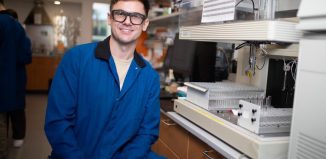SB’s Almécija casts ancient humans in new apelike light
Frustration was mounting as the rejections poured in. His finding could potentially force a rewriting of textbooks and a rethinking of conventional wisdom on something near and dear to people: human evolution.
Sergio Almécija, a researcher in the Department of Anatomical Sciences at Stony Brook Medical School, had used state-of-the-art three-dimensional imaging to look at the femur (the thick thigh bone) of so-called Millennial Man, a fossil that was discovered in 2000. His finding was sufficiently different from what other scientists believed that some of them probably figured he was wrong, he said.
The bone was from an ape that lived about six million years ago, during the end of the Miocene period. These extinct apes haven’t exactly commanded the spotlight, especially in human evolution. Chimpanzees, who are the most closely linked to humans in DNA resemblance, are considered the most likely human cousins.
An analysis of this femur, however, suggests that human ancestors may have looked less like an earlier version of chimpanzees and more like a version of a fossil ape that doesn’t exist today.
Millennial Man, who was bipedal, is widely accepted as an early member of the human lineage, Almécija said. In the past, it was considered human-like in this femur bone. It has also been considered more similar to Australopithicus, like Lucy, and in between living apes and modern humans.
This study, however, shows that the femur is intermediate in time and shape between Lucy and previous apes that lived in the Miocene period, but not to chimpanzees.
“Our study shows that we should focus more attention on and understand those ancient fossil apes,” Almécija said.
He compared the femur of Millennial Man, known by its scientific name as Orrorin tugenensis, to all the living apes — gibbons, siamangs, orangutans, gorillas and chimps, as well as to modern humans, fossil humans and fossil apes. “I believe Orrorin represents a very good model of how the earliest bipeds would look,” he said.
The research paper has been translated into several languages, with people from the United States, Spain and France contacting the Stony Brook professor to discuss the implications of his finding.
Almécija came up with this idea about the apes back in 2010, but it took almost three years to find a publication that would share his work. “We tried to publish this in other journals, but some wouldn’t even allow us to share this with reviewers,” he said.
In some ways, what didn’t kill the idea made it stronger, Almécija suggested. Each rejection created an opportunity to improve the work and clarify the message. The paper has evolved and the researchers have learned a great deal along the way, he said.
Almécija received the support of department chair William Jungers, a distinguished teaching professor in Anatomical Sciences at Stony Brook Medical School. Jungers discussed the results and encouraged Almécija to continue to move forward, despite the roadblocks.
Calling Almécija’s data, methods and results “novel, refreshing and profound,” Jungers said he “offered encouragement and some suggestions to improve his message because I was confident that reason and good science would ultimately prevail. And it did.”
Jungers suggested that textbooks will need to move away from the idea that living apes are the best window into early human evolution. Living apes, he continued, are specialized because they’ve been evolving for millions of years.
The chimpanzee is not a time machine that allows humans to look at a living ancestor. Miocene apes are much better candidates for what human ancestors likely looked like, Jungers said.
When the paper finally moved closer to publication, Almécija celebrated with members of his department, including his girlfriend Ashley Hammond, who is a research instructor. “She knows how hard it was for me to get this thing through,” Almécija said of Hammond, who lives with him in Port Jefferson. When the couple met two years ago while they were both working at the American Museum of Natural History, Almécija was already conducting an analysis of the femur.
The couple, who enjoy the beaches and being close to water, is thrilled to be a part of the Anatomical Sciences Department at Stony Brook, which Almécija described as the “top department in the world in functional morphology and human evolution.”
As for the next step with his research, Almécija said he wants to “understand the evolutionary changes in the skeleton of fossil apes and early hominins. Connecting the dots between a chimp and a human is not going to tell us most of the story, but only the last chapter of the book.”






